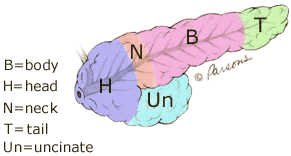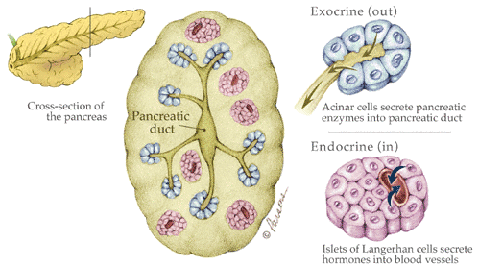What is the pancreas?
A simple answer is that the pancreas is an oblong flattened gland located deep in the abdomen. Most people don't know as much about the pancreas as they do about other parts of their bodies. In fact, this gland is an integral part of the digestive system that often goes unnoticed until problems occur. If you are concerned about pancreas cancer, you will want a lot more information.
Where is the pancreas?
The pancreas is located deep in the abdomen, sandwiched between the stomach and the spine. It lies partially behind the stomach. The other part is nestled in the curve of the duodenum (small intestine). To visualize the position of the pancreas, try this: Touch the thumb and "pinkie" finger of your right hand together, keeping the other three fingers together and straight. Then, place your hand in the center of your belly just below your lower ribs with your fingers pointing to the left. Your hand will be at the approximate level of your pancreas.
Because of the pancreas' deep location, tumors are rarely palpable (able to be felt by pressing on the abdomen.) It also explains why many symptoms of pancreatic cancer often do not appear until the tumor grows large enough to interfere with the function of nearby structures such as the stomach, duodenum, liver, or gallbladder.
Parts of Pancreas
The pancreas is made up of glandular tissue and a system of ducts. The main duct is the pancreatic duct which runs the length of the pancreas. It drains the pancreatic fluid from the gland and carries it to the duodenum. The main duct is about one-sixteenth of an inch in diameter and has many small side branches. The pancreatic duct merges with the bile duct to form the ampulla of Vater (a widening of the duct just before it enters the duodenum.) Your doctor will probably refer to different parts of the pancreas when discussing your situation. The part of the pancreas that a tumor arises in will effect how it is treated. For descriptive purposes, there are two ways the pancreas is divided into parts: by parts of the overall shape and by the function of its cells. Fig. 1-2
The Shape of the Pancreas
- Uncinate Process The part of the gland that bends backwards and underneath the body of the pancreas. Two very important blood vessels, the superior mesenteric artery and vein cross in front of the uncinate process.
- Head The widest part of the gland. It is found in the right part of abdomen, nestled in the curve of the duodenum which forms an impression in the side of the gland.
- Neck The thin section between the head and the body of the gland.
- Body The middle part of gland between the neck and the tail. The superior mesenteric blood vessels run behind this part of the gland.
- Tail The thin tip of gland in the left part of abdomen in close proximity with the spleen.
Pancreas Function
The pancreas can also be thought of as having different functional components, the endocrine and exocrine parts. Tumors can arise in either part. However, the vast majority arise in the exocrine (also called non-endocrine) part. Since the parts have different normal functions, when tumors interfere with these functions, different kinds of symptoms will occur.
- Islets of Langerhans These are the endocrine (endo= within) cells of the pancreas that produce and secrete hormones into the bloodstream. The pancreatic hormones, insulin and glucagon, work together to maintain the proper level of sugar in the blood. The sugar, glucose, is used by the body for energy.
- Acinar cells These are the exocrine (exo= outward) cells of the pancreas that produce and transport chemicals that will exit the body through the digestive system. The chemicals that the exocrine cells produce are called enzymes. They are secreted in the duodenum where they assist in the digestion of food.
What function does the pancreas serve?
The pancreas is an integral part of the digestive system. The flow of the digestive system is often altered during the surgical treatment of pancreatic cancer. Therefore it is helpful to review the normal flow of food before reading about surgical treatment.
Food is carried from the mouth to the stomach by the esophagus. This tube descends from the mouth and through an opening in the diaphragm. (The diaphragm is a dome shaped muscle that separates the lungs and heart from the abdomen and assists in breathing.)
Immediately after passing through the diaphragm's opening, the esophagus empties into the stomach where acids that break down the food are produced. From the stomach, the food flows directly into the first part of the small intestine, called the duodenum. It is here in the duodenum that bile and pancreatic fluids enter the digestive system.
What is bile?
Bile is a greenish-yellow fluid that aids in the digestion of fats. After being produced by cells in the liver, the bile travels down through the bile ducts which merge with the cystic duct to form the common bile duct. The cystic duct runs to the gallbladder, a small pouch nestled underneath the liver. The gallbladder stores extra bile until needed. The common bile duct actually enters the head of the pancreas and joins the pancreatic duct to form the ampulla of Vater which then empties into the duodenum. Flow of bile indicated by green arrows.
What is pancreatic fluid?
Instead of carrying bile, the pancreatic duct carries the pancreatic fluid produced by the acinar cells (exocrine) of the pancreas. The pancreatic duct runs the length of the pancreas and joins the common bile duct in the head of the pancreas. These ducts join to form the ampulla of Vater which then empties into the duodenum. Flow of pancreatic fluid indicated by dark yellow arrow.
The food, bile and pancreatic fluid travels through many more feet of continuous intestine including the rest of the duodenum, jejunum and ileum which comprise the small intestine, then through the cecum, large intestine, rectum, and anal canal.
Info on this page from Johhns Hopkins





